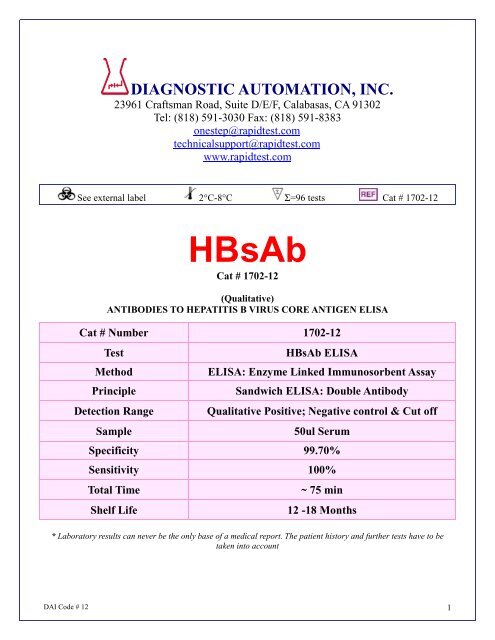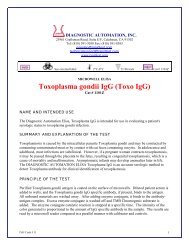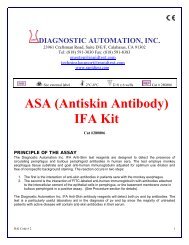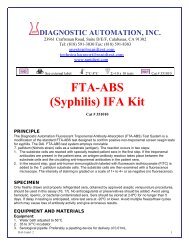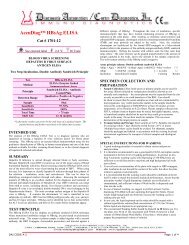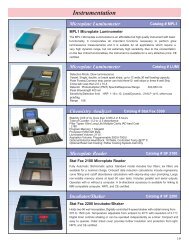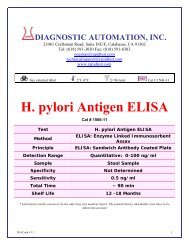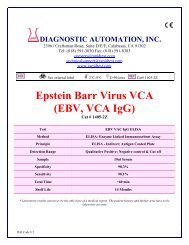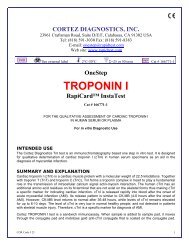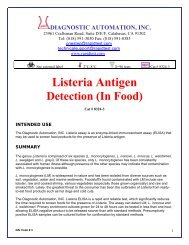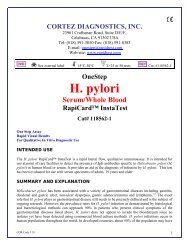HBsAb - ELISA kits - Rapid tests
HBsAb - ELISA kits - Rapid tests
HBsAb - ELISA kits - Rapid tests
- No tags were found...
Create successful ePaper yourself
Turn your PDF publications into a flip-book with our unique Google optimized e-Paper software.
DIAGNOSTIC AUTOMATION, INC.<br />
23961 Craftsman Road, Suite D/E/F, Calabasas, CA 91302<br />
Tel: (818) 591-3030 Fax: (818) 591-8383<br />
onestep@rapidtest.com<br />
technicalsupport@rapidtest.com<br />
www.rapidtest.com<br />
See external label 2°C-8°C Σ=96 <strong>tests</strong> Cat # 1702-12<br />
<strong>HBsAb</strong><br />
Cat # 1702-12<br />
(Qualitative)<br />
ANTIBODIES TO HEPATITIS B VIRUS CORE ANTIGEN <strong>ELISA</strong><br />
Cat # Number 1702-12<br />
Test<br />
Method<br />
Principle<br />
Detection Range<br />
Sample<br />
<strong>HBsAb</strong> <strong>ELISA</strong><br />
<strong>ELISA</strong>: Enzyme Linked Immunosorbent Assay<br />
Sandwich <strong>ELISA</strong>: Double Antibody<br />
Qualitative Positive; Negative control & Cut off<br />
50ul Serum<br />
Specificity 99.70%<br />
Sensitivity 100%<br />
Total Time<br />
Shelf Life<br />
~ 75 min<br />
12 -18 Months<br />
* Laboratory results can never be the only base of a medical report. The patient history and further <strong>tests</strong> have to be<br />
taken into account<br />
DAI Code # 12 1
INTENDED USE<br />
The purpose of the <strong>HBsAb</strong> <strong>ELISA</strong> Test is for clinical lab diagnosis of patients who are<br />
suspected of having a hepatitis B virus infection. This anti-HBs <strong>ELISA</strong> test is an enzyme-linked<br />
immunosorbent assay for in vitro qualitative identification of antibodies to hepatitis B surface<br />
antigen (anti-HBs) in human serum/plasma.<br />
SUMMARY<br />
The effects of HBV infection range anywhere from mild to severe hepatitis which includes<br />
chronic liver problems, such as carcinoma and cirrhosis. As part of the Hepadnaviridae family,<br />
HBV is an enveloped, double-stranded DNA virus that is a primary cause of hepatitis<br />
transmission through blood. In order to classify hepatitis B infection, the serological markers<br />
need to be identified during the three phases of the infection - incubation, acute, and<br />
convalescent.<br />
An important protein of the envelope structure of the virus is the hepatitis B surface antigen<br />
(HBSAg) which appears soon after infection. During the acute phase of the disease, HBsAg is<br />
detectable in blood and this is what makes it a key serological marker for identification and<br />
diagnosis of HBV. There is recovery after treatment. There can also be a progression to long<br />
chronic carrier stage if the infection has progressed for more than six months. It is at the acute<br />
critical stage of infection that a strong immunological response occurs. Markers for recovery<br />
are the expanding titers of HBsAg neutralizing antibodies (anti-HBs). Crucial reasons why<br />
serological detection of anti-HBs is important: a critical technique for follow up with HBV<br />
infected patients, monitoring of their vaccination with synthetic and natural HBsAg-based<br />
vaccines, and possible prevalence studies of HBV.<br />
PRINCIPLE OF THE ASSSAY<br />
The <strong>HBsAb</strong> <strong>ELISA</strong> Test kit employs an antigen sandwich <strong>ELISA</strong> technique where polystyrene<br />
microwell strips are pre-coated with recombinant HBsAg. The test begins by having a<br />
combination of patient's serum or plasma sample being added to Horseradish Perioxidase<br />
(HRP-Conjugate) to the microwells. If anti-HBs is present, the pre-coated and conjugated<br />
antigens will be bound to the two variable domains of the antibody. A specific immunocomplex<br />
is formed and captured on the solid phase during incubation. When washing is complete (to<br />
remove unbound HRP-conjugates and sample serum proteins), chromogen solutions<br />
containing Tetramethylbenzidine (TMB) and urea peroxide are added to the wells. The<br />
colorless chromogens are hydrolyzed by the bound HRP-Conjugate to a blue-colored product<br />
when there is a presence of antigen-antibody-antigen (HRP) sandwich complex. After<br />
stopping the reaction with sulfuric acid, the blue color turns yellow. The color intensity can be<br />
gauged proportionally to the amount of antibody captured in the wells, and to the amount in the<br />
sample, respectively. The wells remain colorless if the anti-HBs result is negative.<br />
Assay principle scheme: Double antigen sandwich <strong>ELISA</strong><br />
Ag(p) +Ab(s) + (Ag)ENZ → [Ag(p)–Ab(s)–(Ag)ENZ] →Blue→Yellow ( +)<br />
Ag(p) + (Ag)ENZ → [Ag (p) ] →No Color ( - )<br />
DAI Code # 12 2
COMPONENTS<br />
96 Tests<br />
• MICROWELL PLATE 1 plate<br />
Blank microwell strips fixed on a white strip holder.<br />
The plate is sealed in aluminium pouch with desiccant.<br />
8×12/12×8-well strips per plate. Each well contains<br />
purified HBsAg. The microwell strips can be broken to be<br />
used separately. Place unused wells or strips in the plastic<br />
sealable storage bag together with the desiccant<br />
and return to 2~8°C.<br />
• NEGATIVE CONTROL 1vial<br />
Yellowish liquid filled in a vial with green screw cap.<br />
1ml per vial. Protein-stabilized buffer tested<br />
non-reactive for anti-HBs.<br />
Preservatives: 0.1% ProClin 300.<br />
Ready to use as supplied. Once open,<br />
stable for one month at 2-8°C.<br />
• POSITIVE CONTROL 1vial<br />
Red-colored liquid filled in a vial with red screw cap.<br />
1ml per vial. anti-HBs diluted in protein-stabilized buffer.<br />
Preservatives: 0.1% ProClin 300.<br />
Ready to use as supplied. Once open,<br />
stable for one month at 2-8°C.<br />
• HRP-CONJUGATE REAGENT 1vial<br />
Red-colored liquid filled in a white vial with red screw cap.<br />
6.5ml per vial. Horseradish peroxidase-conjugated HBsAg.<br />
Ready to use as supplied. Once open,<br />
stable for one month at 2-8°C.<br />
• STOCK WASH BUFFER 1 bottle<br />
Colorless liquid filled in a clear bottle with white screw cap.<br />
30ml per bottle.PH 7.4, 20 × PBS (Contains<br />
Tween 20 as a detergent).<br />
DILUTE BEFORE USE: The concentrate must be<br />
diluted 1 to 20 with distilled/deionized water before use.<br />
Once diluted, stable for one week at room temperature or for<br />
two weeks when stored at 2-8°C.<br />
• CHROMOGEN SOLUTION A 1 vial<br />
Colorless liquid filled in a white vial with green screw cap.<br />
7ml per vial. Urea peroxide solution.<br />
Ready to use as supplied.<br />
Once open, stable for one month at 2-8 °C.<br />
• CHROMOGEN SOLUTION B 1 vial<br />
Colorless liquid filled in a Brown vial with brown screw cap.<br />
7 ml per vial. TMB solution (Tetramethyl benzidine<br />
dissolved in citric acid).<br />
Ready to use as supplied.<br />
Once open, stable for one month at 2-8 °C.<br />
DAI Code # 12 3
• STOP SOLUTION 1vial<br />
Colorless liquid filled in a white vial with white screw cap.<br />
7ml per vial.Diluted sulfuric acid solution (2.0 M H 2 SO 4 ).<br />
Ready to use as supplied.<br />
• PLASTIC SEALABLE BAG 1unit<br />
For enclosing the strips not in use.<br />
• CARBOARD PLATE COVER 1sheet<br />
To cover the plates during incubation and prevent evaporation<br />
or contamination of the wells.<br />
• PACKAGE INSERTS 1 copy<br />
ADDITIONAL MATERIALS AND INSTRUMENTS REQUIRED BUT<br />
NOT PROVIDED<br />
- Freshly distilled or deionized water.<br />
- Disposable gloves and timer.<br />
- Appropriate waste containers for potentially contaminated materials.<br />
- Disposable V-shaped troughs.<br />
- Dispensing system and/or pipette (single or multichannel), disposable pipette tips<br />
- Absorbent tissue or clean towel.<br />
- Dry incubator or water bath, 37±0.5°C.<br />
- Microshaker for dissolving and mixing conjugate with samples.<br />
- Microwell plate reader, single wavelength 450nm or dual wavelength 450nm and 630nm.<br />
- Microwell aspiration/wash system.<br />
SPECIMEN COLLECTION, TRANSPORTATION AND STORAGE<br />
1. Sample Collection: Either fresh serum or plasma samples can be used for this assay. Blood<br />
collected by venipuncture should be allowed to clot naturally and completely – the serum/plasma<br />
must be separated from the clot as early as possible as to avoid hemolysis of the RBC. Care should<br />
be taken to ensure that the serum samples are clear and not contaminated by microorganisms. Any<br />
visible particulate matters in the sample should be removed by centrifugation at 3000 RPM for at<br />
least 20 minutes at room temperature, or by filtration on 0.22u filters. Plasma samples collected into<br />
EDTA, sodium citrate or heparin may be tested, but highly lipaemic, icteric, or hemolized samples<br />
should not be used as they could give erroneous results in the assay. Do not heat inactivate<br />
samples. This can cause sample deterioration.<br />
2. Transportation and Storage: Store samples at 2-8°C. Samples not required for a ssaying within 3<br />
days should be stored frozen (-20°C or lower ).Multiple freeze-thaw cycles should be avoided. For<br />
shipment, samples should be packaged and labeled in accordance with the existing local and<br />
international regulations for transport of clinical samples and ethological agents.<br />
SPECIAL INSTRUCTIONS FOR WASHING<br />
1. A good washing procedure is essential to obtain correct and precise analytical data.<br />
2. It is therefore recommended to use a good quality <strong>ELISA</strong> microplate washer, maintained at the best<br />
level of washing performances. In general, no less than 5 automatic washing cycles with dispensing<br />
of 350-400µl/well, are sufficient to avoid false positive reactions and high background (all wells turn<br />
yellow).<br />
DAI Code # 12 4
3. To avoid cross-contaminations of the plate with sample or HRP-conjugate, after incubation do not<br />
discard the content of the wells, but allow the plate washer to aspirate it automatically.<br />
4. It is recommended that the washing system should be calibrated on the kit itself in order to match<br />
the declared analytical performances. Assure that the microplate washer’s liquid dispensing<br />
channels are not blocked or contaminated, and sufficient volume of Wash buffer is dispensed each<br />
time into the wells.<br />
5. In case of manual washing, we suggest to perform at least 5cycles, dispensing 350-400µl/well and<br />
aspirating the liquid for 5times. If poor results (high background) are observed, increase the<br />
washing cycles or soaking time per well.<br />
6. In any case, the liquid aspirated out the strips should be treated with a sodium hypochlorite<br />
solution(final concentration of 2.5%) for 24 hours, before liquids are disposed in an appropriate way.<br />
7. The concentrated Washing buffer should be diluted 1 to 20 before use. For one plate, mix 30 ml of<br />
the concentrate with 570ml of water for a final volume of 600ml diluted Wash Buffer. If less than a<br />
whole plate is used, prepare the proportional volume of solution.<br />
STORAGE AND STABILITY<br />
The components of the kit will remain stable through the expiration date indicated on the label and<br />
package when stored between 2-8 °C, do not freeze. To assure maximum performance of this HBsAg<br />
<strong>ELISA</strong> kit, during storage protect the reagents from contamination with microorganism or chemicals.<br />
PRECAUTIONS AND SAFETY<br />
This kit is intended FOR IN VITRO USE ONLY<br />
FOR PROFESSIONAL USE ONLY<br />
The <strong>ELISA</strong> assay is a time and temperature sensitive method. To avoid incorrect result, strictly follow<br />
the test procedure steps and do not modify them.<br />
1. Do not exchange reagents from different lots, or use reagents from other commercially available<br />
<strong>kits</strong>. The components of the kit are precisely matched as to achieve optimal performance during<br />
testing.<br />
2. Make sure that all reagents are within the validity indicated on the kit box and are of the same lot.<br />
Never use reagents beyond the expiry date stated on reagents labels or on the kit box.<br />
3. CAUTION - CRITICAL STEP: Allow the reagents and samples to stabilize at room temperature<br />
(18-30°C) before use. Shake reagent gently before, and return to 2-8°C immediately after use.<br />
4. Use only sufficient volume of sample as indicated in the procedure steps. Failure to do so, may<br />
cause in low sensitivity of the assay.<br />
5. Do not touch the bottom exterior of the wells; fingerprints or scratches may interfere with microwell<br />
reading.<br />
6. When reading the results, ensure that the plate bottom is dry and there are no air-bubbles inside<br />
the wells.<br />
7. Never allow the microplate wells to dry after the washing step. Immediately proceed to the next<br />
step. Avoid the formation of air-bubbles when adding the reagents.<br />
8. Avoid assay steps long time interruptions. Assure same working conditions for all wells.<br />
9. Calibrate the pipette frequently to assure the accuracy of samples/reagents dispensing. Always use<br />
different disposal pipette tips for each specimen and reagents as to avoid cross-contaminations.<br />
Never pipette solutions by mouth.<br />
10. The use of automatic pipettes is recommended.<br />
11. Assure that the incubation temperature is 37°C inside the incubator.<br />
12. When adding samples, avoid touching the well’s bottom with the pipette tip.<br />
DAI Code # 12 5
13. When reading the results with a plate reader, it is recommended to determine the absorbance at<br />
450nm or at 450nm with reference at 630nm.<br />
14. All specimens from human origin should be considered as potentially infectious.<br />
15. Materials from human origin may have been used in the kit. These materials have been tested with<br />
<strong>tests</strong> <strong>kits</strong> with accepted performance and found negative for antibodies to HIV ½, HCV, TP and<br />
HBsAg. However, there is no analytical method that can assure that infectious agents in the<br />
specimens or reagents are completely absent. Therefore, handle reagents and specimens with<br />
extreme caution as if capable of transmitting infectious diseases. Strict adherence to GLP (Good<br />
Laboratory Practice) regulations can ensure the personal safety. Never eat, drink, smoke, or apply<br />
cosmetics in the assay laboratory.<br />
16. Bovine derived sera may have been used in this kit. Bovine serum albumin (BSA) and fetal calf sera<br />
(FCS) are derived from animals from BSE/TSE free-geographical areas.<br />
17. The pipette tips, vials, strips and sample containers should be collected and autoclaved for 1hour at<br />
121°C or treated with 10% sodium hypochlorite for 30minutes to decontaminate before any further<br />
steps for disposal.<br />
18. The Stop solution (2M H 2 SO 4 ) is a strong acid. Corrosive. Use it with appropriate care. Wipe up<br />
spills immediately or wash with water if come into contact with the skin or eyes. ProClin 300 used<br />
as a preservative can cause sensation of the skin.<br />
19. The enzymatic activity of the HRP-conjugate might be affected from dust, reactive chemical, and<br />
substances like sodium hypochlorite, acids, alkalins etc. Do not perform the assay in the presence<br />
of such substances.<br />
20. Materials Safety Data Sheet (MSDS) available upon request.<br />
21. If using fully automated microplate processing system, during incubation, do not cover the plates<br />
with the plate cover. The tapping out of the remainders inside the plate after washing, can also be<br />
omitted.<br />
ASSAY PROCEDURE<br />
Step1 Reagents preparation: Allow the reagents and samples to reach room temperature (18-30°C)<br />
for at least 15-30minutes. Check the Wash buffer concentrate for the presence of salt<br />
crystals. If crystals have formed in the solution, resolubilize by warming at 37°C until crystals<br />
dissolve. Dilute the stock Wash Buffer 1 to 20 with distilled or deionized water. Use only clean<br />
vessels to dilute the buffer.<br />
Step2 Numbering Wells: Set the strips needed in strip-holder. and number sufficient number of wells<br />
including three for the Negative control (e.g. B1, C1, D1), two for the Positive control (e.g. E1,<br />
F1) and one Blank (e.g. A1, neither samples nor HRP-Conjugate should be added into the<br />
Blank well). If the results will be determined by using dual wavelength plate reader, the<br />
requirement for use of Blank well could be omitted. Use only number of strips required for the<br />
test.<br />
Step3 Adding Sample and HRP-Conjugate: Add 50µl of Positive control, Negative control, and<br />
specimen into their respective wells. Note: Use a separate disposal pipette tip for each<br />
specimen, Negative and Positive Control as to avoid cross-contamination. Add 50µl HRP-<br />
Conjugate to each well except the Blank, and mix by tapping the plate gently.<br />
Step4 Incubating: Cover the plate with the plate cover and incubate for 60 minutes at 37°C. It is<br />
recommended to use thermostat-controlled water tank to assure the temperature stability and<br />
humidity during the incubation. If dry incubator is used, do not open the door frequently.<br />
Step5 Washing: At the end of the incubation, remove and discard the plate cover. Wash each well<br />
5times with diluted Wash buffer. Each time, allow the microwells to soak for 30-60 seconds.<br />
After the final washing cycle, turn the plate down onto blotting paper or clean towel, and tap it to<br />
remove any remainders.<br />
DAI Code # 12 6
Step6 Coloring: Dispense 50µl of Chromogen A and 50µl Chromogen B solution into each well<br />
including the Blank, and mix by tapping the plate gently. Incubate the plate at 37°C for<br />
15minutes avoiding light. The enzymatic reaction between the Chromogen solutions and the<br />
HRP-Conjugate produces blue color in Positive control and HBsAg positive sample wells.<br />
Step7 Stopping Reaction: Using a multichannel pipette or manually, add 50µl Stop Solution into<br />
each well and mix gently. Intensive yellow color develops in Positive control and HBsAg<br />
positive sample wells.<br />
Step8 Measuring the Absorbance: Calibrate the plate reader with the Blank well and read the<br />
absorbance at 450nm.If a dual filter instrument is used, set the reference wavelength at<br />
630nm. Calculate the Cut-off value and evaluate the results (Note: read the absorbance within<br />
5minutes after stopping the reaction).<br />
INTERPRETATION OF RESULTS AND QUALITY CONTROL<br />
Each microplate should be considered separately when calculating and interpreting results of the assay,<br />
regardless of the number of plates concurrently processed. The results are calculated by relating each<br />
sample’s optical density (OD) value to the Cut-off value (C.O.) of the plate. If the Cut-off reading is<br />
based on single filter plate reader, the results should be calculated by subtracting the Blank well OD<br />
value from the print report values of samples and controls. In case the reading is based on dual filter<br />
plate reader, do not subtract the Blank well OD from the print report values of samples and controls.<br />
1. Calculation of Cut-off value: Cut-off value (C.O.) = *Nc × 2.1<br />
*Nc = the mean absorbance value for three negative controls.<br />
Important: If the mean OD value of the negative control is lower than 0.05, take it as 0.05 .If<br />
higher than 0.05 see the Quality control range.<br />
Example:<br />
1. Calculation of Nc:<br />
Well No B1 C1 D1<br />
Negative controls OD value 0.02 0.012 0.016 Nc= 0.016<br />
(the Nc value is lower than 0.05 so take it as 0.05)<br />
2. Calculation of Cut-off value: Cut-off (C.O) = 0.05 x 2.1 = 0.105<br />
If one of the Negative control values does not meet the Quality control range specifications, it should be<br />
discarded and the mean value is calculated again using the remaining two values. If more than one<br />
negative control OD value does not meet the Quality control range specifications, the test is invalid and<br />
must be repeated.<br />
2. Quality control range:<br />
The test results are valid if the Quality Control criteria are verified. It is recommended that each<br />
laboratory must establish appropriate quality control system with quality control material similar to or<br />
identical with the patient sample being analyzed<br />
1. The OD value of the Blank well, which contains only Chromogens and Stop solution, is less than<br />
0.080 at 450 nm.<br />
2. The OD value of the Positive control must be equal to or greater than 0.800 at 450/630nm, or at<br />
450nm after blanking.<br />
3. The OD value of the Negative control must be less than 0.100 at 450/630nm or at 450nm after<br />
blanking.<br />
3. Interpretations of the results:<br />
(S = the individual optical density (OD) of each specimen)<br />
Negative Results (S/C.O.
negative, for this assay which indicates that no hepatitis B virus surface antigen have probably not been<br />
detected with this kit. Therefore, there are no serological indications for past infection and the individual<br />
is not immune against infection with HBV.<br />
Positive Results (S/C.O.≥1): samples giving an absorbance greater than or equal to the Cut-off value<br />
are considered initially reactive, which indicates that antibodies to HBV surfaces antigen have been<br />
detected using this anti-HBs <strong>ELISA</strong> kit. Retesting in duplicates of any reactive samples is<br />
recommended. Repeatedly reactive samples could be considered positive for anti-HBs. Elevated<br />
concentration of anti-HBs are indication for recovery and immunity to HBV.<br />
Borderline (S/C.O. =0.9-1.1): Samples with absorbance to Cut-off ratio between 0.9 and 1.1 are<br />
considered borderline and retesting of these samples in duplicates is recommended to confirm the<br />
results. Repeatedly positive samples can be considered positive for antibodies to HBsAg.<br />
Follow-up and supplementary testing of any positive samples with other HBV assays is required before<br />
establishing of the final diagnosis.<br />
TEST PERFORMANCE AND EXPECTEC RESULTS<br />
Analytical Endpoint Sensitivity (lower detection limits): The assay shows sensitivity near the Cutoff<br />
of 5mIU/ml.<br />
Clinical Specificity: The clinical specificity of the assay has been determinate by a panel of samples<br />
obtained from 1500 healthy blood donors and 250 undiagnosed hospitalized patients.<br />
Clinical Sensitivity: The clinical sensitivity of the assay has been calculated by a panel of samples<br />
obtained from 580 hepatitis B patients with well-characterized clinical history based upon reference<br />
assays for detection of HBsAg, HBeAg, anti-HBs, anti-HBe, and anti-HBc. Licensed anti-HBs <strong>ELISA</strong><br />
test was applied as a confirmatory assay. For establishing the test performance characteristics during<br />
monitoring of post-vaccination antibody response, additional group of samples from 200 individuals<br />
receiving HBV vaccine was tested for anti-HBs.<br />
The evaluation results are given below. Results obtained in individual laboratories may differ.<br />
Specificity<br />
Samples<br />
True<br />
positive<br />
Specificity<br />
False<br />
positive<br />
No. - +<br />
Donors 1500 870 631 630 99.88% 1<br />
Patients 250 141 110 109 99.29% 1<br />
TOTAL 1750 1011 741 739 99.58 2<br />
Sensitivity<br />
Samples<br />
True Sensitivity False<br />
No. - + positive<br />
negatives<br />
Acute 350 345 5 5 100% 0<br />
Chronic 130 129 0 0 100% 0<br />
Recovery 100 5 95 95 100% 0<br />
Vaccine<br />
200 7 193 193 100% 0<br />
recipients<br />
TOTAL 780 486 293 293 100% 0<br />
DAI Code # 12 8
Analytical Specificity:<br />
1. No cross reactivity observed with samples from patients infected with HAV, HCV, HIV, CMV, and TP.<br />
2. No interference from rheumatoid factors up to 2000U/ml observed.<br />
3. The assay performance characteristics are unaffected from elevated concentrations of bilirubin,<br />
hemoglobin, and triolein.<br />
4. No high dose hook effect up to 150000mlU/ml.<br />
5. Frozen specimens have been tested too to check for interferences due to collection and storage.<br />
Reproducibility: Within Run Between Run<br />
Specimen Type No Mean OD CV% Mean OD CV%<br />
Weak positive 10 0.457 9.0% 0.443 9.5%<br />
Moderate positive 10 1.570 7.5% 1.497 7.0%<br />
Strong positive 10 2.310 4.4% 2.250 4.2%<br />
30mlU 10 0.523 6.2% 0.508 6.7%<br />
Positive control 10 2.132 4.2% 2.016 4.2%<br />
LIMITATIONS<br />
1. Non-repeatable positive result may occur due to the general biological of the <strong>ELISA</strong> assays. This<br />
assay is designed to achieve very high performance characteristics of sensitivity and specific and the<br />
‘’sandwich model’’ minimizes the unspecific reactions due to interference with unknown matters in<br />
sample. However, in very rare cases some HBV mutants or subtypes can remain undetectable. A<br />
negative results with an antibody detection test does not preclude the possibility of infection.<br />
2. If, after retesting of the initially reactive samples, the assay results are negative, these samples<br />
should be considered as non-repeatable (false positive) and interpreted as negative. As with many<br />
very sensitive <strong>ELISA</strong> assays, false positive results can occur due to the several reasons, most of<br />
which are related but not limited to inadequate washing step. Any positive results must be interpreted<br />
in conjunction with patient clinical information and other laboratory results.<br />
3. Common source for mistakes: <strong>kits</strong> beyond the expiry date, bad washing procedures, contaminated<br />
reagents, incorrect assay procedure steps, insufficient aspiration during washing, failure to add<br />
samples or reagents, equipment, timing, volumes, samples nature and quality.<br />
4. The prevalence of the marker will affect the assay’s predictive values.<br />
5. Samples tested using test <strong>kits</strong> from different manufacturer can give similar qualitative results but<br />
some samples can give discrepancies due to the antibodies diversity and the antigenic properties of<br />
HBsAg used in the assay.<br />
6. This kit is intended ONLY for testing of individual serum or plasma samples. Do not use it for testing<br />
of cadaver samples, saliva, urine or other body fluids, or pooled (mixed) blood.<br />
7. This is a qualitative assay and the results cannot be use to measure antibodies concentrations.<br />
INDICATIONS OF INSTABILITY OR DETERIORATION OF THE<br />
REAGENTS<br />
1. Values of the Positive or Negative controls, which are out of the indicated Quality control rage, are<br />
indicator of possible deterioration of the reagents and/or operator or equipment errors. In such case,<br />
the results should be considered as invalid and the samples must be retested. In case of constant<br />
erroneous results classified as due to deterioration or instability of the reagents, immediately<br />
substitute the reagents with new ones.<br />
2. If after mixing of the Chromogen A and B solution into the wells, the, the color of the mixture turns<br />
blue within few replace the reagents with fresh ones.<br />
DAI Code # 12 9
VALIDITY<br />
Please do not use this kit beyond the expiry date indicated on the kit box and reagent labels.<br />
REFERENCES:<br />
1. Lewis, T., et al. (1972). A Comparison of the frequency of hepatitis-B Antigen and antibody in hospital<br />
on non-hospital personnel. New Engl. J. Med., 289, 647.<br />
2. Hadler, S.C., et al. (1986). Long-term Immunogenicity and Efficacy of Hepatitis B vaccine in<br />
homosexual men. New Engl. J. Med. 315,209.<br />
3. Jig. W., et al. (1989). Vaccination against Hepatitis B: Comparison of three different vaccination<br />
schedules. J. Infect. Dis., 160,766.<br />
4. Jig, W., et al. (1990). Hepatitis B-vaccination strategy for booster doses in high-risk population<br />
groups. Progress in Hepatitis B Immunisation. P. Coursaget, M.J. Tong eds., Colloque INSERM. 194,<br />
419.<br />
5. Engvall E. and Perlmann P. J.Immunochemistry, 8, 871-874, 1971.<br />
6. Engvall E. and Perlmann P. J.Immunol. 109, 129-135, 1971.<br />
7. Remington J.S. and Klein J.O. In ‘’Infectious diseases of the fetus and newborn infant’’. Sanders,<br />
Philadelphia, London, Toronto.<br />
8. Volk W.A. In ‘’Essential of Medical Microbiology’’. 2 nd ed., pp 729 G.B. Lippincott Company,<br />
Philadelphia, New York, S.Jose, Toronto.<br />
Date Adopted Reference No.<br />
2008-01-05 DA-<strong>HBsAb</strong>-2009<br />
DIAGNOSTIC AUTOMATION, INC.<br />
23961 Craftsman Road, Suite D/E/F, Calabasas, CA 91302<br />
Tel: (818) 591-3030 Fax: (818) 591-8383<br />
ISO 13485-2003<br />
Revision Date: 9/17/2012<br />
DAI Code # 12 10


